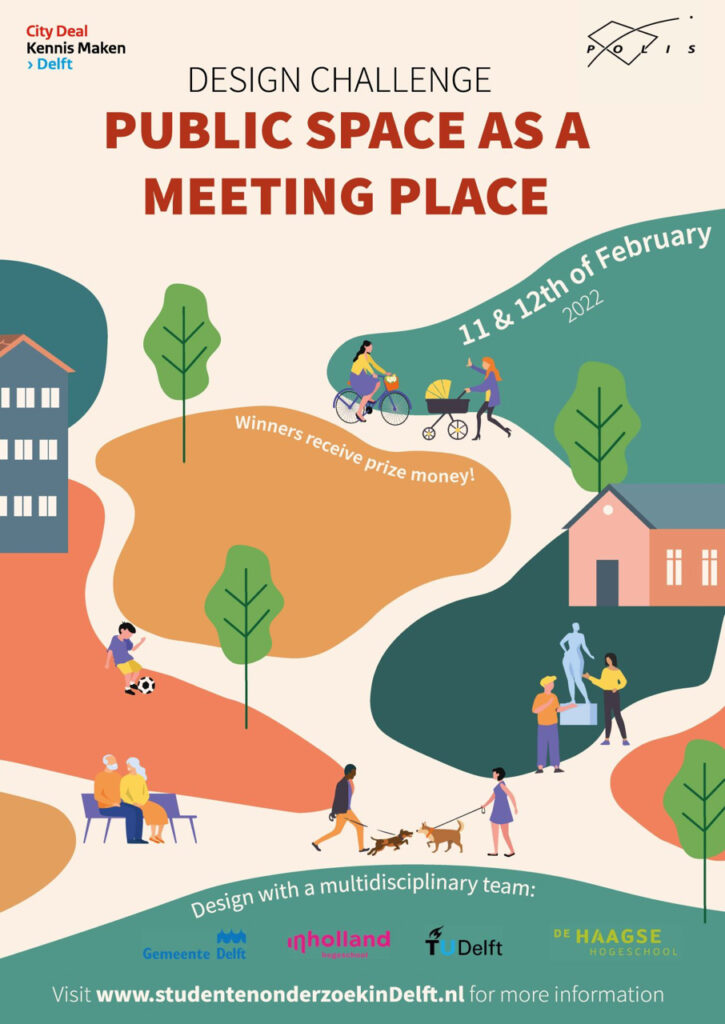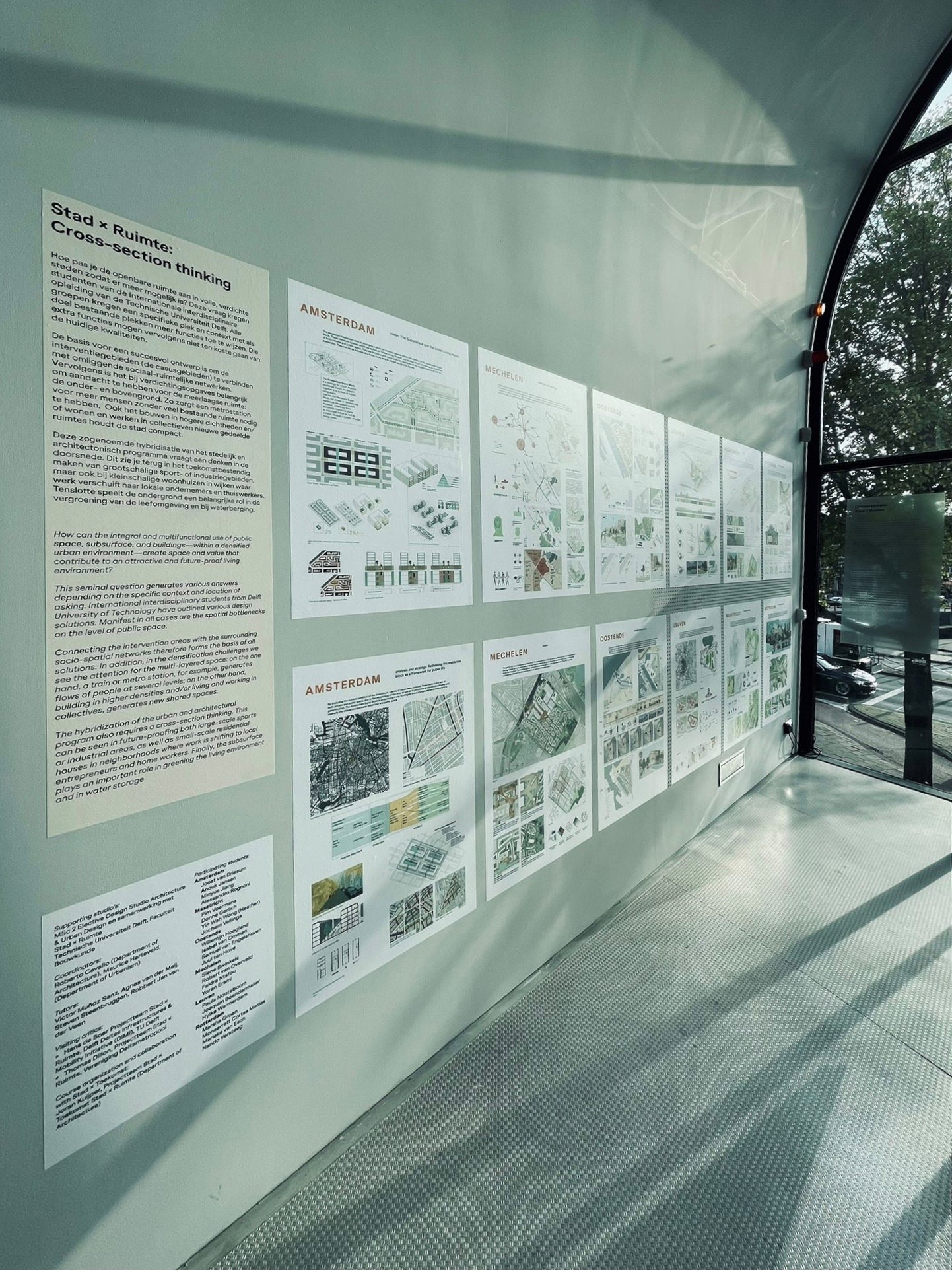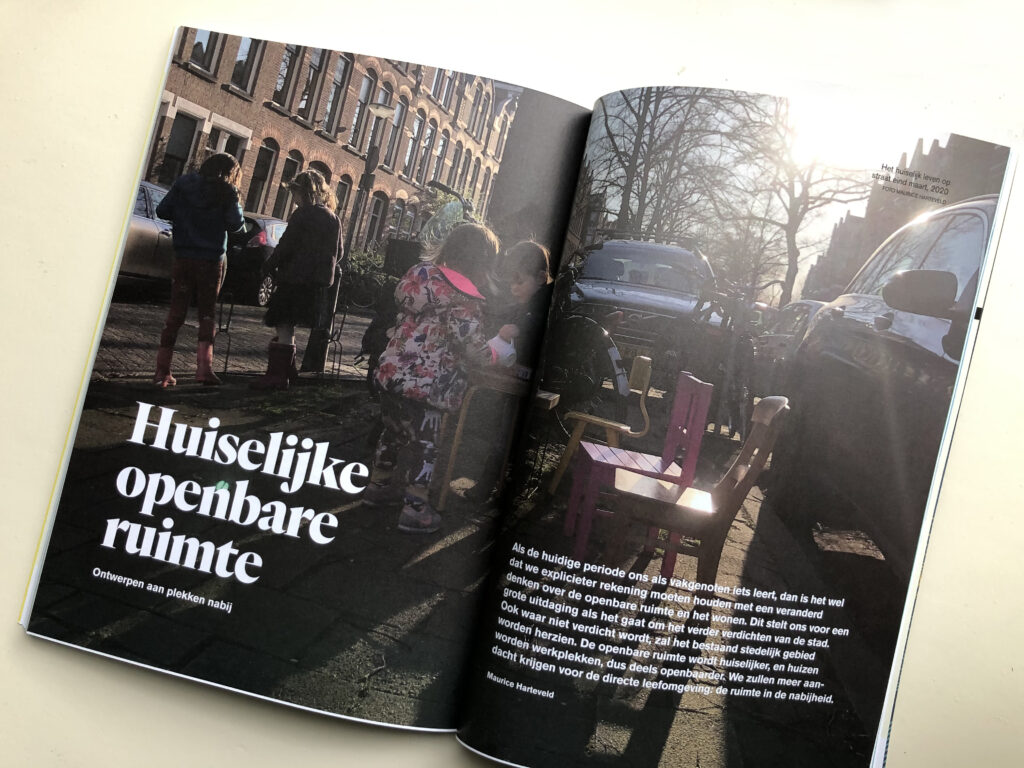How to Design Public Space for Maritime Mindsets? That’s a central question in the new Minor ‘Minor (Re)Imagining Port Cities: Understanding Space, Society, and Culture’.
Category Archives: real cities
Designing Domestic Places
| Public space is the place to play, move and meet. This applies to our rich city center with all its shops and restaurants, but just as much to residential areas. But how can we make these public spaces even more attractive for all types of users? At the beginning of February, students from TU Delft, The Hague University of Applied Sciences, and Inholland University of Applied Sciences developed various ideas for the public space in the Tanthof district. In various teams, the students have investigated how existing routes or routes to be designed can be provided with ‘stopping points’: places where you can rest for a while, look around and chat with other residents. During this meeting of Delft Design, these design sketches will be briefly explained and we would like to discuss these design sketches with you and, among others, Tako Postma (City Architect of Delft), Eveline Berghout – van der Schee (urban designer, City of Delft), Maurice Harteveld (researcher, Design of Public Spaces, TU Delft), Ben Kuipers (landscape architect) and Flip Krabbendam ( architect) in a discussion about the preconditions for successful public space. The discussion starts with a lecture on Designing Domestic Places by Maurice Harteveld Afterward, there is an opportunity to chat and view the different designs. This while enjoying a snack and drink. The challenge is organized by Delft Design in collaboration with the City Deal Kennis Maken Delft, study association POLIS and architect Flip Krabbendam. | De openbare ruimte is dé plek voor spelen, bewegen én ontmoeten. Dat geldt voor onze rijke binnenstad met al zijn winkels en horeca, maar even zo goed voor woonwijken. Maar hoe kunnen we deze publieke ruimten nog aantrekkelijker maken voor alle type gebruikers? Begin februari hebben studenten van de TU Delft, De Haagse Hogeschool en Hogeschool Inholland verschillende ideeën uitgewerkt voor de openbare ruimte in de wijk Tanthof. In verschillende teams hebben de studenten onderzocht hoe bestaande of nieuw te ontwerpen routes kunnen worden voorzien van ‘halteplaatsen’: plekken waar men even kan uitrusten, kan rondkijken en een praatje kan maken met andere bewoners. Tijdens deze bijeenkomst van Delft Design worden deze ontwerpschetsen kort toegelicht en gaan we graag met u en onder andere Tako Postma (stadsbouwmeester van Delft), Eveline Berghout – van der Schee (stedebouwkundige. City of Delft), Maurice Harteveld (onderzoeker, Design of Public Spaces, TU Delft), Ben Kuipers (landschapsarchitect) en Flip Krabbendam (architect) in gesprek over de randvoorwaarden van succesvolle openbare ruimte. De discussie wordt geopend met een lezing over Het Ontwerpen van Huiselijke Plekken door Maurice Harteveld Na afloop is er gelegenheid tot napraten en het bekijken van de verschillende ontwerpen. Dit onder het genot van een hapje en drankje. De challenge wordt georganiseerd door Delft Design in samenwerking met de City Deal Kennis Maken Delft, studievereniging POLIS en architect Flip Krabbendam. |
The Public Space as Meeting Place
De Openbare Ruimte als Ontmoetingsplek
where:
Prinsenkwartier en online
when:
2 March 2020
open 19.30, start 20.00 untill 22.00
Design Challenge for Students
City Deal ‘Kowlegde Making Delft’ is organising a challenge about the use and design of public space for ambitious students who would like to push their boundaries. How can we make the public space more attractive for all types of users as a place to play, move and to meet?

More: Design Challenge: Public Space as a Meeting Place
Partners:
the Municipality of Delft
The Hague University of Applied Sciences
Inholland University of Applied Sciences
Delft University of Technology
Delft Design
Stress Reduction and Healing
Rosalie Moesker, an urban designer in training in our team, makes the cross-over to health. As the campus of Erasmus Medical Centre densifies, not only accessibility is at stake, more so, the human experience while traveling. In the city of the future, the medical centre needs new mobility concepts. When we design for these, we can relieve users of worries by reducing urban stress at their arrival, and rethinking public space as a healing environment during stay.
source: TV Rijnmond, Tuesday, November 16, 17:35
Continue reading
Expo SubTerra
New Roots for Underground Urbanism – Exhibition

photo by Joran Kuijpers
City x Space: Cross-Section Thinking
How can the integral and multifunctional use of public space, subsurface, and buildings -within a densified urban environment – create space and value that contribute to an attractive and future-proof living environment?
“This seminal question generates various answers depending on the specific context and location of asking. International interdisciplinary students from Delft University of Technology have outlined various design solutions. Manifest in all cases are the spatial bottlenecks on the level of public space. Connecting the intervention areas with the surrounding socio-spatial networks, therefore, forms the basis of all solutions. In addition, in the densification challenges we see the attention for the multi-layered space: on the one hand, a train or metro station, for example, generates flows of people at several levels; on the other hand, building in higher densities and/or living and working in collectives, generates new shared spaces.” As Maurice Harteveld explains in the exhibition; “The hybridization of the urban and architectural program also requires a cross-section thinking. This can be seen in future-proofing both large-scale sports or industrial areas, as well as small-scale residential houses in neighborhoods where work is shifting to local entrepreneurs and home workers. Finally, the subsurface plays an important role in greening the living environment and in water storage.”
Continue reading
500 Days at Home
 Deserted public space in Rotterdam, the Netherlands. Image by Maurice Harteveld.
Deserted public space in Rotterdam, the Netherlands. Image by Maurice Harteveld.
“After working from home for more than five hundred days, our daily lives and rituals have been severely changed by the COVID-19 pandemic. Moreover, social distancing and other measures have affected everyone’s access to public space and exposed a range of impacts on different levels. Researchers from more than twenty universities explore those impacts in the new open-access publication ‘2020: A Year without Public Space under the COVID-19 Pandemic’.
The crisis in early 2020 immediately brought together the global community of experts on the design of public space. Maurice Harteveld (Urbanism) is part of the scientific board of the Journal of Public Space and distinctly remembers how the initiation of lockdown upon lockdown sparked debate: “Chief editor Luisa Bravo was already in lockdown in the north of Italy, another colleague soon followed in Hong Kong. The progressively worsening health situation led to images of abandoned public space. We started to share local insights, forming a global perspective on the issues arising from the pandemic for the current situation of public space. By connecting with UN-Habitat, the United Nations Human Settlements Programme, this became an opportunity to re-think how cities should be.”Deserted public space in Rotterdam, the Netherlands. Image by Maurice Harteveld.
Health Disparity, Public Space Restrictions and the Future of Public Space
Shared online initiatives resulted in experts from across the world exchanging experiences of care, solidarity, entrepreneurship, academic perspectives, artistic interpretations, and creative practices of human resilience. The resulting key learnings from the early stage of the pandemic are encapsulated in the publication. The research addresses questions like how we can prepare for the consequences of this unprecedented emergency, particularly health disparity, but also addresses the impact of public space restrictions. More generally, the learnings reflect on what the future of public space might be.
At first glance, the challenges for each urban region might look different. Harteveld: “I vividly remember how Casper Chigama, a community developer from Zimbabwe gave an online presentation from his car, addressing how the local concerns there were about how social distancing might be achieved in the short term. But in the long term, pre-existing concerns on urban hygiene were the main challenge. Another colleague from New York City, Setha Low, mentioned how, even with urban hygiene relatively well organised, she still noticed disparity in access to qualitative public space between different population groups of the city.” In the end, the solutions to these challenges might lie within the same realm of making public space more recognisable on a local scale. People should not only have access to public space from their own homes, they should also be able to identify themselves with these places. “We stay closer to home, shown by trends like the increase of working from home and online shopping, and the consecutive decrease of commuting and going to the city centre,” explains Harteveld. “We clearly saw this in 2020, but the trend already emerges in the 1980s. Today, that means we need to be able to feel at home within the public space. As designers and planners of urban space, we can actively contribute to the detailing and programming of the public space to make such attachments possible.” Harteveld calls this the ‘domestication’ of public space. Fellow researchers observe the same, also at places where urban hygiene and inequality is of urgent concern. Josephine Mwongeli Malonza mentions for example how neighbourhood streets function as public space in Kimisange, Rwanda. The future of public space is local, equitably accessible, and very much an interesting and continuing challenge for urban designers, planners, legislators, and other city dwellers.”
#500Days @Home
The 500th day at home passed by on Monday 19 July, 2021
Published:
2020: A year without public space
July 2021
Domesticated Public Space
Domestication Will Shape Future Public Spaces
A Report from Rotterdam
This commentary aims to provide a window on the future by studying actions, taken to control the spreading of the coronavirus, while obviously affecting public space over a year. What have been the effects on public space directly linked to these actions during the pandemic; what values play a role, and what can we expect for the future? We have seen how immediate responses induced by the COVID-19 crisis influences traveling, gathering, and public life in general. Now, it is time to look further. Having a base-point in Rotterdam and taking The Netherlands as an example, the commentary argues that some shifts in using, appropriating, and experiencing public space will remain. Yet, mainly
those not just being immediate responses to sudden societal change, rather those which
are embedded in long-term change.
Read Open Access Article: Harteveld, Maurice (2020) “Domestication Will Shape Future Public Spaces”, The Journal of Public Space, Vol. 5, No. 3, pp. 53-66. doi: https://doi.org/10.32891/jps.v5i3.1379.
[Re]Thinking Cities

2020: A Year without Public Space under the COVID-19 Pandemic!
new publication of The Journal of Public Space
The Journal of Public Space published ‘2020: A Year without Public Space under the COVID-19 Pandemic’. This monumental publication of 280 pages witnesses the year we all lived on social distance dictated by COVID-19 health emergency, a measurement severely affected everyone’s access to public space and with it creating a range of impacts on different levels. Delft University of Technology, as a worldwide recognised leader in the field of urban design and public space, united with more than twenty universities globally to question; how can we face this unprecedented emergency and get prepared to its consequences, with specific regard to health disparity? Will public space restrictions stay in place after the recovery period? Should we just aim to return to a pre-COVID status quo, or for a ‘better normal’? And more generally, what will be the future of public space?
Maurice Harteveld, part of the scientific board, remembers how the situation induced by the COVID-19 crisis in early 2020 immediately brought together the global community of experts on the Design of Public Space; “I remember how the alarm bells didn’t stop anymore in the third week of April. Health situation worsened progressively in China, and a new decree imposing quarantine became in act in Northern Italy. Public space was abandoned there. Without doubt, we started to share local insights and form a global perspective on the issues arising from the pandemic for public space the current situation of public space.” Together with UN-Habitat, the United Nations Human Settlements Programme, this became an opportunity to collaborate to re-think how cities should be.
As the pandemic was moving across different continents and urban conditions, through shared online initiative public space experts across the world exchanged experiences of care, solidarity, entrepreneurship, academic perspectives, artistic interpretations, and creative practices of human resilience, engaging more than 100 speakers during 20 webinars from May to September 2020, and more than 2,700 registered attendees from over 80 countries, including representatives from UNHabitat. Global impact of the online initiative ‘2020: A Year without Public Space under the COVID-19 Pandemic’ has been even broader by counting more than 72,000 page views in that same period. This publication encapsulates key learnings globally from the early stage of the pandemic, which stand relevant to this day when we face squarely the same issues as we step into gradually and navigate the post-COVID era.
Download full issue here
Digital, Virtual, and Physical
Physical Public Space X Virtual Space
Urban designers and landscape architects observe physical public spaces as spaces that are able to accommodate accidental meetings, reveal places’ identity, provide impulsive on-the-spot choices, and allow human-nature interaction through wind or sunshine. However, the recent crisis unfolds the intertwining between physical public space and virtual space. During two days, we focus on the shift of the planner’s outlook on physical public space and virtual space.
Join the webinars!
When: Thursday, November 5 and 6, 9.00am – 6.00pm CET
> Registration
Bits of Public Space 3.0: Trailer, published by Polis on YouTube
Video credits: Ioanna Kokkona
Continue reading
Domestic Public Space
If the current period teaches us, as colleagues, anything explicitly, it is that we must take account of a changed way of thinking on public space and housing. This shift presents us with a major challenge when it comes to further densification of the city. The existing urban fabric needs revision, even in areas where there is no increase in density. Public space is becoming more homely, and houses are becoming workplaces, so partly more public. We will pay more attention to the immediate living environment: the space in the vicinity.

Read the article in Dutch:
Harteveld, Maurice (2020, October) Huiselijke Openbare Ruimte. Ontwerpen aan Plekken Nabij. In: Ruimte + Wonen. #3/2020 Thema Publieke Ruimte, 101e Jaargang, Nummer 3, October 2020, pp. 72-79
Ruimte + Wonen is a Dutch magazine and knowledge network for spatial professionals and housing experts, originated from the magazines S+RO and Tijdschrift voor de Volkshuisvesting. Go to ‘Ruimte + Wonen’ membership
